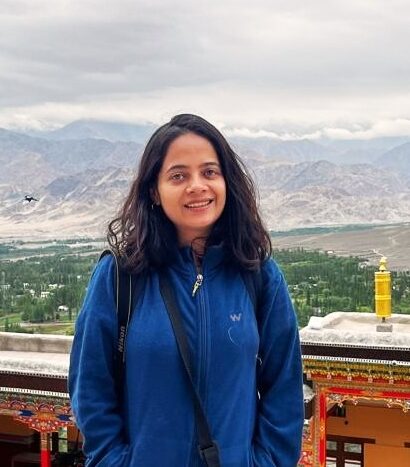Wildflowers, Rivers, and Mountains—Navigating Time and Kinship
Listen to this story. Narrated by Shrishtee Bajpai.
In the rolling meadows of Yumthang Valley, covered in purple primulas and framed by the mighty Himalayas, the rivers Lachen Chu and Lachung Chu tell stories of ancient kinship—a kinship of collective emergence of mountains, rivers, forests, and humans. A kinship that still guides the melodies and rhythms of humans living in this landscape of North-Sikkim, in the northeast of India.
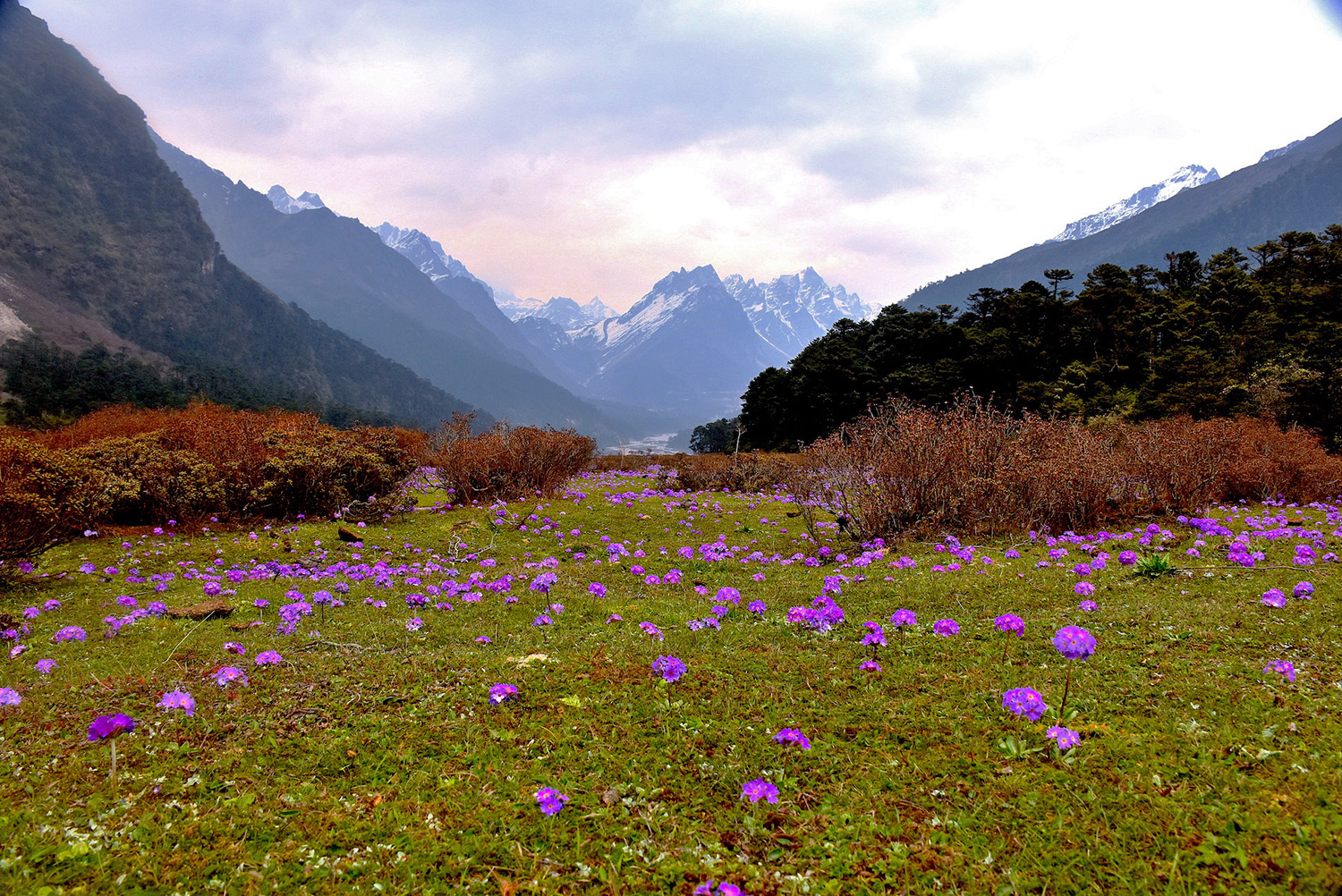
The word “kin” comes from an Indo-European root meaning “give birth to” and is commonly used to denote one’s family and relations. But kinship, in this landscape, goes beyond human ties. What is it like to live along a river as her sister and daughter? What is it to extend one’s selfhood beyond our individual selves? What is it to be relational in our everyday lives with more than humans? What is it to live by the laws of mountains, oceans, rivers, glaciers, and woods? These questions are a constant presence in our daily lives, urging us to be vigilant and embrace our responsibilities in the world.
Two rivers move down the valley from the sacred and mighty Kanchenjunga peak—Lachen Chu and Lachung Chu. At times, emerald and cerulean, these rivers carry many stories, trickles, sediments, and ways of being. In April 2024, we drove along the banks of Lachung Chu and met one of her tributaries, Talung River, in its upper reaches. Bright streaks of red, white, purple, and pink flowering rhododendrons covered the entire stretch of the valley.
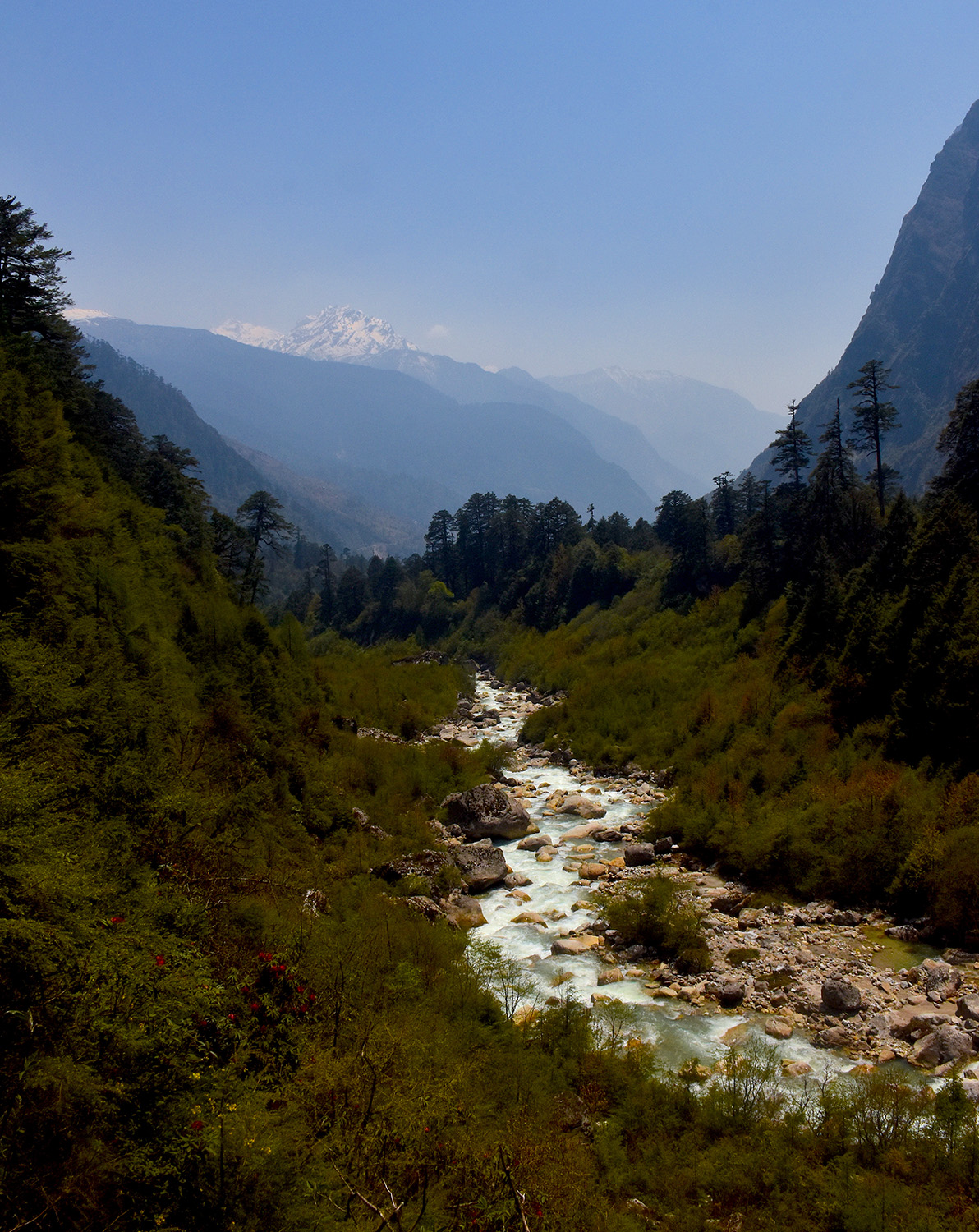
“The river has a right to flow; what else could it be!” said Hishey Lachungpa, a river activist, wildflowers enthusiast, resident of Lachung village and our host, as we strolled around the forests of Lachung Chu. In 2006, Lachung village led a strong protest against the proposed hydropower projects on their river and decided to disallow any further attempts to destroy the river and her ecology. Hishey organized a protest in Lachung, disclosing the proposal’s details and spreading awareness among the community members about the impacts of large-scale hydropower projects. “I had seen the destruction Chungthang dam caused in the villages in the lower valley. I couldn’t let the dam come up in my village. It would have destroyed everything,” said Hishey as we looked at Chungthang dam downstream that was washed away in the floods in 2023. On October 4 of that year, a 1,200 MW Teesta-III hydroelectric project called the Chungthang dam on river Teesta broke out, killing at least 94 people in the downstream areas of Sikkim and West Bengal. It was wise and visionary for the people of Lachung to decide against dam construction. After three years of agitation, in 2009, the Dzumsa (village assembly) of Lachung agreed to ban any hydropower projects on their rivers. They have, in fact, criminalized discussing or proposing dams in any public spaces in Lachung.
Moving through the birch, temperate silver fir-rhododendron, and hemlock forest next to the bubbling Lachung Chu River, I digressed a little into my thoughts-wondering how Lachungpas (also known as the Bhutia tribe) have been protecting this landscape—where multiple timescapes co-exist. Eastern Himalayas, fragile and young in the earth’s history, are 70 million years old—the youngest mountain range in the world! Rivers that have flowed, meandered, and flooded these landscapes have done so for approximately a million years. And then there are deities who have been protecting these landscapes for a few thousand years. There are wildflowers, rhododendrons, primulas, poppies, irises, and countless other varieties that paint the meadows in a breathtaking display for a short period of 2-3 months every year, with each flower having a unique time within this short span.
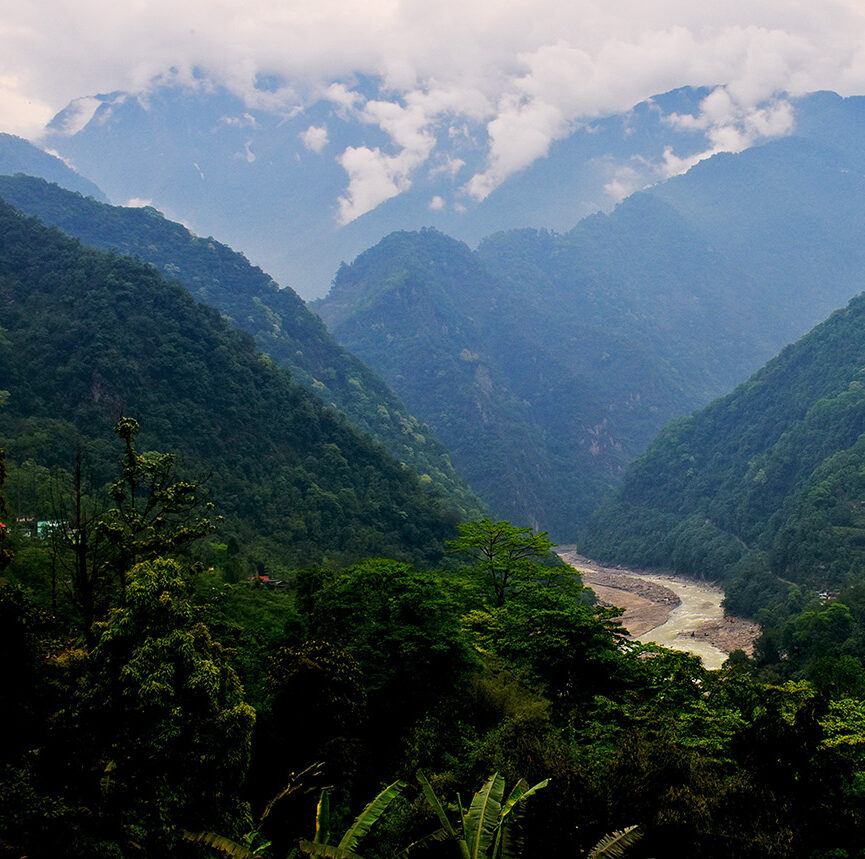
Communities living in these varied timescapes have always nurtured kinship, believing in the circularity of time rather than its linearity.
Thinking of time beyond the linearity of past-present-future but instead tied together in a circle in which events are met with a sense of infiniteness attached to them. “We don’t want to tunnel our ecosystems. All we have is our rivers, mountains and forests. If we destroy them, how will we survive?” asked Tsewang Gyalson Lachungpa, an elder from Lachung who recently retired from his government job. For Gyalson Lachungpa and his community, this shared responsibility of protecting their rivers and landscapes extends beyond the past, present, and future. Rather, it is nurturing multi-species existence by connecting past generations and the ones yet to come through the present. Hence, the weather cycles, cloud formations, spirits, and beings in the forest and mountains are active and present participants in all decision-making. Indigenous peoples and other nature-dependent local communities have long communicated and connected with the more-than-human world, recognizing everything as alive and possessing agency. The indigenous sense of responsibility and kinship extends beyond humans and time as well.
In a fantastic essay by Kyle Whyte, where he writes about Time as Kinship, he says that kinship time “promotes interdependence through shared responsibilities. Responsibilities operate best when they have qualities attached to them, including trust, consent, and reciprocity, among others.” I am reminded of what Izam sai Katengey, an Adivasi activist from central India, once told me, “Changla Jeevan Jage Mayan Saathi Sapalorukoon Apu Apuna Jababdarita Jaaniv Ata Pahe” (To achieve well-being, everyone needs to know what their responsibility is). In Gondi, there is no word or expression for entitlements or rights; their language emphasizes duties and responsibilities. The Gonds, along with many indigenous communities in India, believe that their sense of responsibility expands to all humans and more than humans. The cosmovisions are part of these communities’ aesthetics rooted in their gritty experience, intuitive intelligence, and interdependence.
Yet, this understanding of time as circular is now in the margins. This interdependence and reciprocity, based on the beautiful human gift of attention, is destroyed every day. Our relationships and interdependence with the rest of nature have been ruptured. In an effort to mend this rupture and destruction, the world now articulates crises and solutions through the lens of linear time—a perspective with a clear beginning, end, and a sense of finiteness. There is always a sense of urgency, detached from our responsibility to reflect on where we live, who we are, and how our privileges shape us. This logic often dominates climate debates, discussions, and solutions such as carbon offsets, geo-engineering, and large-scale solar power, among others.

And so, what has happened? Arturo Escobar, Michal Osterweil, and Kriti Sharma, in their new book, Relationality: An Emergent Politics of Life Beyond the Human, argue that the crises lie in the stories being told to us. The dominant story tells us that all humans must pass through “Stages of Progress” to be truly “developed.” They argue that the key to constructing livable worlds lies in cultivating ways of knowing and acting based on a profound awareness of the fundamental interdependence of everything that exists—what they refer to as relationality. What would it mean if one were to extend it to more than humans? For me, it would mean cultivating nurturance, attention, listening, and love within and around us.
It is about re-earthing our lives and finding the everyday praxis of essential human dwelling. But can we re-earth ourselves beyond the hegemonic, secular, modern notion of humanity? Many of our current ways of relating, especially in urban areas, are rooted in modern, scientific approaches to nature. While this isn’t entirely problematic, how can we broaden the horizon to navigate a more-than-human worldview beyond the confines of the “rationalist” perspective? What would that praxis look like?
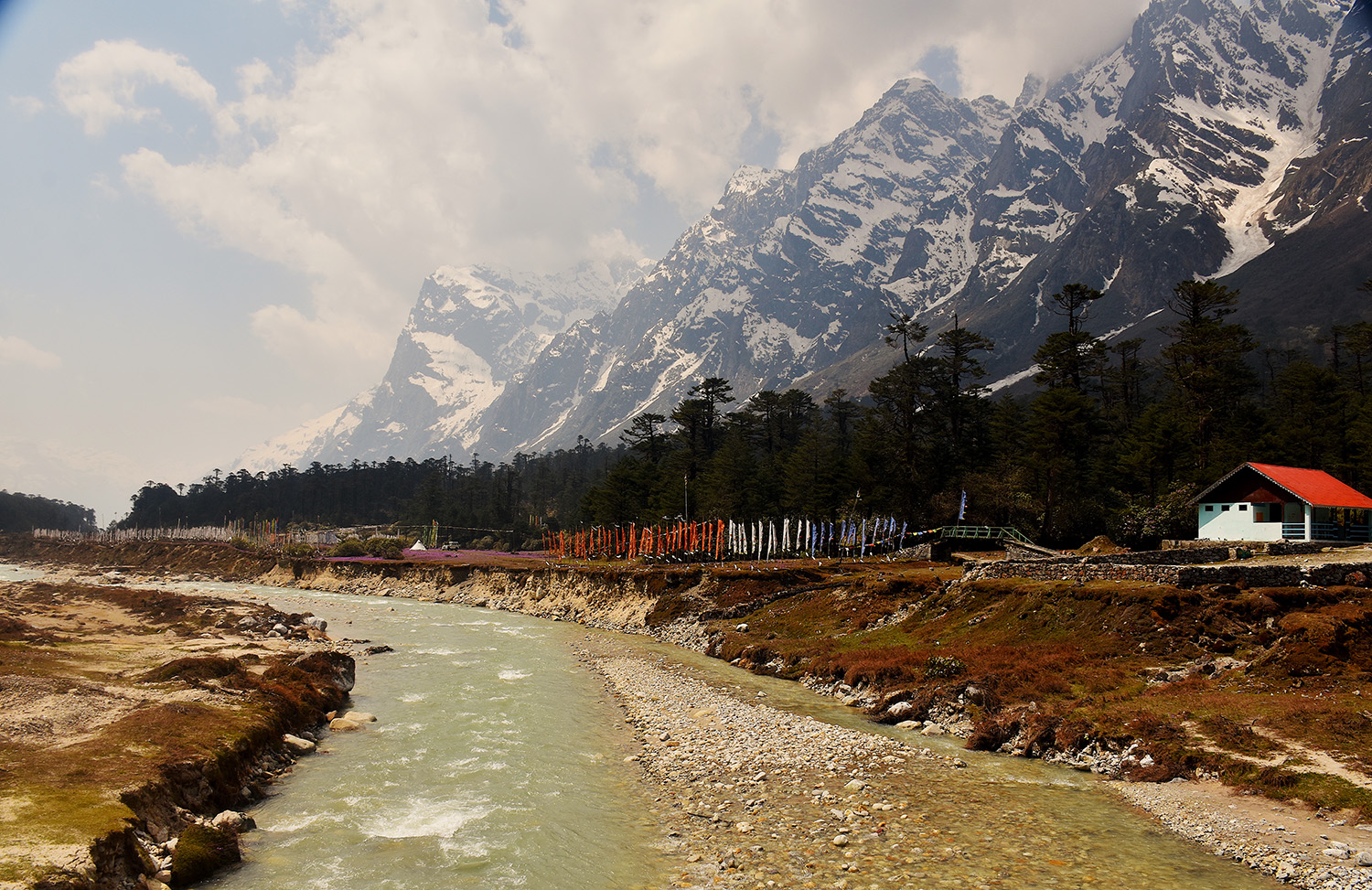
I am reminded of something Hishey said to us while walking around the Lachung Chu River: “The river that takes care of us, but are we listening to her enough?” Hishey and several other communities ask us: Are we tapping into the wisdom of these different timescapes and landscapes? Are we listening to our kith and kin?
Along the Lachung Chu River that day, as we moved further into the birch forests, a tiny Eurasian wren zoomed past my face. It perched restlessly, inspecting her surroundings and unexpected visitors. We continued moving ahead, listening to the singing forests. Gingerly, I asked Hishey if there was any chance of ibisbill. “Less likely,” he said. My heart sank a little. It was the ibisbill, a bird I had been searching for many years. The ibisbill, related to waders, is known for its distinct long, curved bill and is found near streams and rivers in the western and eastern Himalayas. We were at a perfect habitat near a boulder-strewn, high-altitude river where it can easily camouflage. Sitting on the grassy meadows blanketed with purple primula flowers, I scanned the valley through my binoculars, holding onto just enough hope. There was an intuitive sense that it might finally appear—that perhaps, at last, my long search would reach its end.
My eyes moved patiently through boulders while my body braved the strong wind. Just as my dry eyes were about to give up, a bluish-grey bird with a distinct, long, hooked red bill flew into view. I looked through my binoculars for a minute to ensure I was looking at an ibisbill. It perched on a boulder, and as I strained to see it, I lost it. Hesitatingly, I asked Hishey if I could slowly go closer to the river bed, and he said, “Yes, if it is still there. If you really saw it,” and grinned. I moved through marshy land, simultaneously wandering and scanning. I was distracted by a lark, but as I approached the riverbank, there was a sudden movement, and yes, there it was! The ibisbill that I had long waited to see. Alerted by my presence, it started moving. I perched myself instead and had a loving gaze while the bird slowly moved through the edges of the shore, dipping its long bill in the water. I spent about 10 minutes looking at and photographing the elusive beauty until some tourists 30 metres away made a roar, taking selfies and scaring the bird away.

Elated, I sat there, took a deep breath, and admired the river, mountains, and flowers. At that moment, I became aware of the liminal spaces we constantly inhabit but seldom notice—the quiet magic that everyday life offers. I can’t say for sure if the ibisbill responded to my yearning, but I’d like to believe it did. We don’t have to rationalize to be convinced. We can trust our intuitive “knowing.” I recall my conversation with Tiokasin Ghosthorse, a Lakota Native American, on intuitive intelligence. He said,
“Indigenous communities have always held an intuitive way of knowing as an important way of making sense of the world around them.”
Increasingly, my encounters with the more-than-human world are filled with intentions—the intention to rekindle our relationships and ensure that we are always in communication and kinship. Being in contact with the earth. We always are, whether we know it or not. Our collective responsibility is to look for stories of aliveness, kinship, and listening to nature—collectively unravelling tools for modern times that can help us rekindle our relationship with the more-than-human in meaningful ways.
